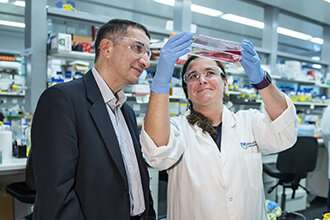Discovery of potential new combination therapy for leukemia

WEHI researchers have discovered why some leukemia cells are resistant to new "SMAC-mimetic' anti-cancer agents, a finding which could improve the use of these drugs in the clinic.
The team discovered that the 'drug pump' protein MDR1 makes acute myeloid leukemia (AML) cells resistant to SMAC-mimetics, by rapidly pumping out the drug of the cells before it can work. Treating AML cells with inhibitors of MDR1 allowed the SMAC-mimetics to accumulate and kill the leukemia cells. These discoveries suggest a new approach to understand which AML patients would respond best to SMAC-mimetics, as well as the potential for SMAC-mimetics and MDR1 inhibitors—which are both in clinical trials—to be used together as a new combination therapy for leukemia or other cancers.
The research was supported by more than $80,000 in funding from more than 400 donors. It was published in Blood Advances by a team led by Dr. Gabriela Brumatti, Dr. Emma Morrish and Professor John Silke from WEHI, in collaboration with researchers from Monash University, the University of Adelaide and the Peter MacCallum Cancer Center.
Overcoming drug resistance
SMAC-mimetics are a promising new class of anti-cancer agents that have entered clinical trials for certain solid and blood cancers. Dr. Brumatti said many cancers, unfortunately, didn't respond to these agents.
"Many teams, including ours, have now begun to investigate whether SMAC-mimetics could be more effective if they are combined with other anti-cancer agents," she said. "We decided to undertake a systematic search for new drugs that could improve the response of leukemia cells to SMAC mimetics, and tested almost 6000 drug-like inhibitors of different cellular proteins.
"Our research focussed on AML, an aggressive blood cancer which has very poor outcomes for many patients—and for which better treatments are urgently needed."
This 'needle in a haystack' search provided only a handful of drug candidates, one of which was an inhibitor of MDR1, said Dr. Morrish, who was a Ph.D. student at WEHI.
"MDR1 is a protein found in healthy cells, but can become elevated in some cancers. The protein pumps certain molecules out of cells. In nature, this protects healthy cells from the accumulation of toxins, but in cancer cells MDR1 can pump anti-cancer medicines out of the cell, stopping them from working and making the cancer resistant to the drugs," Dr. Morrish said.
"We speculated that MDR1 could remove SMAC-mimetics from AML cells—and found that this was indeed the case. The good news is that drugs that inhibit MDR1—blocking the pump—are already in clinical trials. When we tested these drugs in combination with SMAC-mimetics, we saw that the AML cells retained the SMAC-mimetics and started to die."
"This suggests that MDR1 inhibitors could potentially be combined with SMAC-mimetics to create an effective new combination treatment. Excitingly, we already know from early-stage clinical trials that both drugs are well-tolerated, so we are hopeful this could be a safe drug combination."
Dr. Brumatti said an exciting aspect of the research was that the combination of MDR1 inhibitors and SMAC-mimetics could also kill leukemia "stem cells," which are thought to be a source of cancer recurrence. "This discovery is important, because it suggests the drug combination could provide long-term benefits for patients, reducing their risk of recurrence," she said.
More information: Emma Morrish et al. Clinical MDR1 inhibitors enhance Smac-mimetic bioavailability to kill murine LSCs and improve survival in AML models, Blood Advances (2020). DOI: 10.1182/bloodadvances.2020001576



















